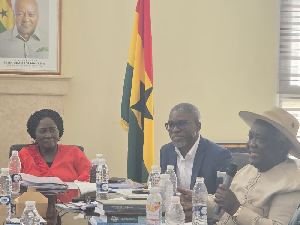Food Security Ghana (FSG) recently touched on the perceived confusion by the Government of Ghana (GoG) on the difference between ³food self-sufficiency² and food security in an article titled ³Food Security in Ghana: Does the Government Understand the Concept? link
As World Food Day 2011 is upon us, these are important issues that should be debated. Important because it affects the lives and well-being of millions of Ghanaians.
While working on its bumper article about food security in Ghana to be released on World Food Day, 16 October 2011, FSG stumbled on an article by Peter Warr (Head of the Arndt-Corden Department of Economics and John Crawford Professor of Agricultural Economics in the College of Asia and the Pacific at the Australian National University).
In his article about the Indonesian situation that is similar to that of Ghana, Peter Warr concludes as follows:
³Policies for pursuing rice self-sufficiency by raising the domestic price of rice are, in effect, policies for transferring massive amounts of money from the pockets of the poorest Indonesian consumers of rice to other, much richer Indonesians: large farmers, absentee landowners, rice millers and quota recipients. The policy achieves Œself-sufficiency¹, but only at the expense of reducing the food security of the most vulnerable people the poorest net consumers.²
That is exactly what FSG has been trying to convey to the GoG. Peter¹s conclusion in the article that appears in full below is:
³A preferable strategy for raising self-sufficiency is to focus more effectively on improving agricultural productivity. This reduces imports by raising agricultural output but does so without raising the domestic price of food and so without creating a conflict between the goals of higher levels of self-sufficiency on the one hand and food security and poverty reduction on the other.²
Maybe the GoG will listen to Peter¹s arguments after refusing to see the light up to now...
Indonesia: Why food self-sufficiency is different from food security The recent volatility of international food prices has reinforced the mistrust felt within many food-importing countries towards international markets as suppliers of affordable food.
One possible response is to become less reliant on food imports. Concern about food security thus becomes transformed into concern about food self-sufficiency. But food security and food self-sufficiency are different things and they can be in conflict. In this paper I will discuss the relationship between these two concepts in the Indonesian context, focusing on the staple food, rice.
According to the World Food Summit of 1996,
Food security exists when all people, at all times, have physical and economic access to enough safe and nutritious food to meet their dietary needs and food preferences for an active and healthy lifestyle.
Indonesia is a net importer of all of its major staple food commodities, including rice, maize, cassava, soybeans and sugar, even though domestic production of each of these commodities is substantial. Prior to the Asian Financial Crisis of 1997 to 1999 rice import policy within Indonesia was to stabilise domestic rice prices at approximately the average international price. Until the early 2000s, Indonesia was the world¹s largest rice importer. With the country¹s transition to a more democratic form of government, the successful lobbying power of pro-farmer political groups led first to heavy tariffs on rice imports. Then, since 2004, rice imports have officially been banned, although limited quantities of imports have periodically been allowed. As a result of this policy, the price of rice within Indonesia has increased relative to other prices by about 40 per cent.
The argument advanced here is not that Indonesia¹s self-sufficiency policy is a bad idea, but that protection policy (the import ban) as an instrument of achieving it results in unnecessary social costs and places food self-sufficiency into conflict with the goals of food security and poverty reduction. The distributional effects of protection policy as a means of reducing imports are the basis of the argument.
Consider the economic effects of a policy of restricting the quantity of rice imports, as under Indonesia¹s Œleaky¹ import ban. The policy acts directly on the quantity of imports but its effect is to raise the domestic price by reducing the availability of imported rice. How much will the domestic price increase? A quantitative restriction on imports acts on the volume imported and lets the domestic price adjust accordingly. The domestic price will increase until the difference between the quantity demanded domestically and the quantity supplied domestically declines to the lower volume of imports now permitted under the quantitative restriction. When both the demand for rice and the supply are price inelastic, as is the case with rice, a large price increase is necessary to achieve this reduction in the volume of imports.
Obviously, people who are net consumers of rice are harmed by an increase in the price. But which consumers are harmed the most? Unfortunately, the answer is: the households for which rice is the highest proportion of their budgets the poorest consumers. This includes not only the urban poor but also most of the rural poor, a surprising majority of whom are net buyers of rice. For example, this includes all landless agricultural labourers people who sell their labour and buy rice.
What about the effect on producers? Obviously, anyone who is a net seller of rice benefits. Who benefits the most? The answer is obvious: those who sell the most thelargest farmers. Small farmers are both consumers and producers of food. Their net sales of rice might be positive or negative or, if they are subsistence farmers, zero. But if their net sales are positive they are small. Price changes have very little net impact on this group of farmers, one way or the other.
Some of the largest beneficiaries are not farmers at all. First, there are absentee landowners. Agricultural product prices become capitalised into the price of agricultural land. Raising the price of rice benefits anyone who owns rice land, or land that could be used to produce rice and these landowners are not necessarily farmers. Second, there are the rice millers. The import restriction operates on milled rice and the immediate impact is on the price of that product, rather than the price of paddy. Rice millers benefit directly from the increase in the price of their product. Paddy prices may increase as a result of the increased price of milled rice, but not necessarily in the same proportion. Third, those importers who receive the limited entitlement to import rice receive a windfall profit the difference between the import price and the higher domestic price multiplied by the quantity of rice they are allowed to import.
Policies for pursuing rice self-sufficiency by raising the domestic price of rice are, in effect, policies for transferring massive amounts of money from the pockets of the poorest Indonesian consumers of rice to other, much richer Indonesians: large farmers, absentee landowners, rice millers and quota recipients. The policy achieves Œself-sufficiency¹, but only at the expense of reducing the food security of the most vulnerable people the poorest net consumers.
A preferable strategy for raising self-sufficiency is to focus more effectively on improving agricultural productivity. This reduces imports by raising agricultural output but does so without raising the domestic price of food and so without creating a conflict between the goals of higher levels of self-sufficiency on the one hand and food security and poverty reduction on the other.
Peter Warr is Head of the Arndt-Corden Department of Economics and John Crawford Professor of Agricultural Economics in the College of Asia and the Pacific at the Australian National University.
Indonesia: why food self-sufficiency is different from food security| glObserver Global Economics
FSG gives Peter Warr a score of 10/10!
Don¹t miss our World Food Day ³Food for Thought in Ghana² article on Sunday, 16 October 2011.
Food Security Ghana
http://foodsecurityghana.com
info@foodsecurityghana.com
Opinions of Saturday, 15 October 2011
Columnist: Food Security Ghana














